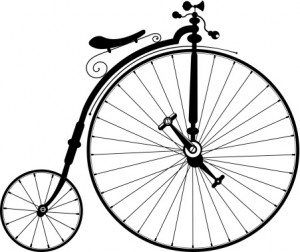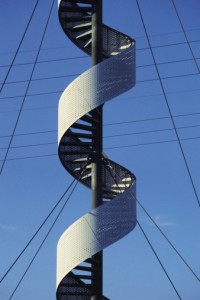Circus of Dreams (Part 17)
By Asher Crispe: December 7, 2012: Category Decoding the Tradition, Inspirations
To Light Up the Night
 Life is not about unicycles. We ride on many wheels of varying sizes, most of which have been pre-owned. While it is possible to forget and think that we are spinning atop something new, in truth our cycles get recycled multiple times. Our set of wheels transports us from place to place, from lifetime to lifetime, from hill to hill. We can even measure our progress with the revolutions of these wheels. Onwards and upwards– this spin class has the soul power of netzach as its Samech-circle instructor. Netzach combines the meaning of nitzchiut as ‘eternity’ with netzachon or ‘victory.’ Collectively, ‘eternity’ is the ‘victory’ over time which would give netzach the connotation of that which can be perpetuated or enduring. Having another chance at life via reincarnation calls upon us to consider how we our going to improve this time ‘around.’ Circularity, when applied to the category of time, creates repetitious patterns or time cycles.
Life is not about unicycles. We ride on many wheels of varying sizes, most of which have been pre-owned. While it is possible to forget and think that we are spinning atop something new, in truth our cycles get recycled multiple times. Our set of wheels transports us from place to place, from lifetime to lifetime, from hill to hill. We can even measure our progress with the revolutions of these wheels. Onwards and upwards– this spin class has the soul power of netzach as its Samech-circle instructor. Netzach combines the meaning of nitzchiut as ‘eternity’ with netzachon or ‘victory.’ Collectively, ‘eternity’ is the ‘victory’ over time which would give netzach the connotation of that which can be perpetuated or enduring. Having another chance at life via reincarnation calls upon us to consider how we our going to improve this time ‘around.’ Circularity, when applied to the category of time, creates repetitious patterns or time cycles.
One essential cluster of proof-texts for the trans (temporal) migration of souls comes from Tikunei Zohar (112a). Beginning with the figure of Moshe/Moses, this kabbalistic treatise asserts that the self-same soul who lead the nation of Israel out of Egypt in ancient times, will return to be the final messianic redeemer. In a certain sense, Moshe/Moses is buried or enclothed within the soul of Moshiach (the Messiah). He get re-in-corp-erated in a manner that skips him through history to link together two events that are separated by the ages of the world. Beyond suturing redemptions past and future, the singularity of the soul of Moshe/Moses finds his way back into the world again and again in every generation. Each generation has a literal extension of Moshe/Moses whose job is to lead the people and connect them to the Torah.
Re-downloading his soul in each generation (he re-generates) happens a thousand times as hinted at in Psalms 105:8 “…the word He commanded for a thousand generations.” We find in the Talmud (Sanhedrin 8a) that the ‘word’ (davar) can also refer to a leader (dabar) whereby it says ‘[there is] one leader for the generation….’ (dabar echad l’dor). Thus, the verse can be read as ‘he [now referring to Moshe/Moses the leader in the generation] commanded for a thousand generations’. We might also ask why a thousand? This number has many interpretations but for now we will have to suffice with just one: elef (thousand) comes from the same root as Alef (the first Hebrew letter) who name can also mean to ‘teach.’ Therefore, the sages learn from this that Moshe/Moses teaches throughout all of the generations and not merely once in the past. He and his teaching are always contemporary having been regularly updated to speak to the concerns and modes of communication of the generation which he is in touch with because he is living though it. He is never merely historical nor out of date. Reiterating Moshe/Moses as the leader par excellence actually drives history as each new appearance of his soul actualizes more latent dimensions within the Torah itself.
Another salient allusion to Moshe/Moses as our archetypal time traveler can be found in Kohelet/Ecclesiastes 1:9 “What was is that which will be (Mah s’haya hu s’yehiyeh)….” The first letters of the first three words in this expression are Mem, Shin, Hei which spell out Moshe/Moses. From this the kabbalists contend that Moshe/Moses is the ‘head’ or prime example of ‘what was’ and ‘that is’ turning into that which ‘will be.’ He is the quintessential recycled soul.
All that applies to a leader like Moshe/Moses (as the exceptional personality who is carried forward and reinscribed throughout history) also applies to the generation in its entirety. All souls have a victory over time and are eternal. But more than that, they return to this world and are perpetuated as reincarnations. This universalizing of the principle of metempsychosis can also be derived from another passage in Kohelet/Ecclesiastes 1:4: “One generation passes away, and another generation comes….” As it is understood in Zoharic literature, this is not two distinct generations but rather the exit and re-arrival of the self-same generation. Once a person passes away, he or she can immediately come back as part of the next generation.
From these two examples we can safely contend that we are minimally riding an old fashion bi-cycle. Perhaps we could correlate the bigger front wheel to the recycling of the leader of the generation (who can contain the whole of the generation within himself) while the smaller back wheel could represent all of the people of the generation. Since the function of the front wheel leads the back wheel, steering and driving it towards its destination, it follows that the task of Moshe/Moses is to demonstrate the larger picture (the big cycle/wheel) while including our smaller cycle/wheel within and making it integral to overall operations.
Yet, the Samech-cycle as repetition cannot be understood as a vicious cycle whereby the same things keep repeating over and over again without any change. The overcoming of netzach also implies overcoming the inertia of the same-old to break out into the different and new. Each additional cycle takes us higher. It opens some previously untapped potential or novel possibility. This can be seen in the month of Kislev and the Festival of Chanukah which are the time of the dedicating of the sacrificial alter in the Temple. In describing the approach and service of the altar by the Cohanim/Priests (who were also the force behind the Chanukah victory over the Greeks) the Talmud (Zevachim 53a) states that the Cohen would “ascend the ramp (alah b’kevesh) and turn to the ledge (sovev) bordering the altar.” Even though the altar itself was square, there was a sounding ledge called the ‘sovev’ (which itself means ‘surrounding’ and which begins with the circular letter Samech) in the form of circle.
In Kabbalah, there are many examples of squaring the circle and circling the square (all of which may generally be thought of as playing off the linear [square] and the non-linear [circle]) and this is one such example. The architectonic of this setup carries a great deal of mystical significance. Why does the Cohen first ascend a ramp before circling the space that is dedicated to drawing us closer to God and closer to each other? Just spinning our wheels doesn’t really get us anywhere. We are likely to just come back to the place where we have always been or get stuck on the same playing field. If we want real progress then we need repetition (surrounding border-space) and difference (ramp). In the gaming world, we don’t just want to go another ‘round’ at the same level of difficultly–we want to level up. The running through another game cycle presents all sort of new challenges but it also get us ‘closer’ (the altar establishes a space for the production of closeness as the word for an ‘offering,’ korban, derives from karov or ‘nearness’) to our objects.
 When we examine the word for the ramp that gives us our vertical lift–kevesh–we can see that it’s root can also imply ‘subjugation’ as in the famous line from the Ethics of the Fathers 4:1 “Who is strong? He who subdues (hakovesh) his negative inclination.” Ascension, according to Chassidic teaching, begins with self-discipline and holding in check one’s destructive drives which, in terms of the mechanics of the self, amounts to suppression therapy or itkafia. Stage two (which moves us even further along) entails putting a positive spin (Samech) on our experience and behavior. Thus, we progress from suppression to sublimation. Walking the surrounding border symbolizes our capacity to turn things around and re-orient them–even from the experiential edge or margin. Transformation or ithafka happens on the periphery.
When we examine the word for the ramp that gives us our vertical lift–kevesh–we can see that it’s root can also imply ‘subjugation’ as in the famous line from the Ethics of the Fathers 4:1 “Who is strong? He who subdues (hakovesh) his negative inclination.” Ascension, according to Chassidic teaching, begins with self-discipline and holding in check one’s destructive drives which, in terms of the mechanics of the self, amounts to suppression therapy or itkafia. Stage two (which moves us even further along) entails putting a positive spin (Samech) on our experience and behavior. Thus, we progress from suppression to sublimation. Walking the surrounding border symbolizes our capacity to turn things around and re-orient them–even from the experiential edge or margin. Transformation or ithafka happens on the periphery.
Teaming both movements–suppression as ramping our game, and transformation as converting the negatives into positives–is tantamount to joining difference to repetition. The wheels break out of their frame and become spirals. The Samech at this level emerges as the figure of an upward spiral aiding in our overcoming (netzach) all spiritual obstacles. Each subsequent reincarnation of ourselves in the adventure of life presents the old as new and changed. Despite resemblances, no two incarnations are the same. The life coach within our head can certainly be heard shouting: ‘This time around make it count! Try harder! Do things differently!’
For Part 18 we will revisit the issue of our nighttime security.
Circus of Dreams (Part 17),













;)
;)
;)
;)
;)
;)
;)
;)
;)
;)
